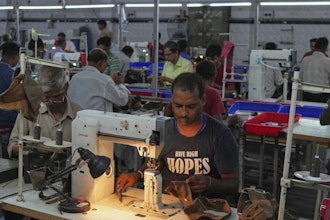LITTLE ROCK (AP) — LM Glasfiber, which is building a $150 million factory to produce windmill blades, on Wednesday showed off the first blade it produced at a temporary facility in Little Rock.
The Denmark-based company has hired 190 workers at the temporary facility, who will move to the new factory once it is complete. The company is using the factory on Scott Hamilton Road as a training center where employees can learn methods and quality standards.
The first blade, 44 yards long, sat in sunshine-lit parking lot Wednesday where employees wearing dark blue commemorative T-shirts posed as a group for a photograph in front of their work.
The workers don't stand back and watch machines do the work, plant manager Dan McDermott said.
''It's a very manual process,'' McDermott said.
The blade, which will be used to turn energy-generating turbines, was molded in two halves that come together lengthwise.
''The layout, painting, sanding are all done by hand,'' McDermott said. ''There is no machine. It comes from 150 skilled craftsmen inside these walls.''
McDermott said others in the industry told him to expect to scrap the first few blades the factory turns out as workers learn their craft.
''We took that as a challenge,'' McDermott said. About 100 workers trained for six weeks at Glasfiber's factory in North Dakota and learned as they filled the plant's first order. The blade on display Wednesday was up to specification and is to be shipped with two others to Acciona Windpower, a Spanish firm the specializes in renewable technologies.
Glasfiber, which has about a third of the world blade market, got the keys to the temporary site only in September.
''It was nothing but a warehouse. We've converted it to a beautiful factory,'' McDermott said.
Now, a special lift slides the huge blades out the large bay doors on the east side of the warehouse.
The company's $150 million permanent factory, being built at the Port of Little Rock, is close to being ready for steel framing and for concrete to be poured, McDermott said. The company has 1,000 orders stacked up, which will take until the end of next year to fill.
Once at the port, Glasfiber will be able to turn out bigger blades. The cutoff for being able to transport blades on the highways is 52.5 yards, but the plant will be able to build even longer blades and transport them by rail or, eventually, by barge, McDermott said. The U.S. marketplace for longer and longer blades is growing, he said.
Randy Zook, a deputy director at the Arkansas Economic Development Commission, said the jobs at Glasfiber pay well and that the workers have plenty of room for advancement. As Glasfiber expands its U.S. presence, Zook said the Little Rock plant will serve as a training center.
''This business is growing so rapidly — 20 to 25 percent a year — that it's all they can do to keep up with growth and demand,'' Zook said.
The company has pledged to have least 500 workers at its permanent plant within two years and 1,000 workers within five years. The company will receive a state tax exemption through 2033 if it meets the hiring goals.
Glasfiber is ''meeting and beating'' the benchmarks, Zook said.
The first workers were hired at $12.75 per hour, about $26,500 per year.


















